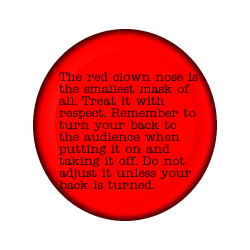|
|
 
Unit
2 - Theatre History
Module
2: Jesters, Tricksters and Fools
Lesson
3 - Clown Character
Introduction:
The
keys to becoming a good clown are simple-
• have fun
• react to situations.
• respond to impulses.
This
lesson will help each actor do all three through warm-ups and
activities.
|
Talking
Circle:
What
do you think of when you think of clown?
Many people only think of the "fright wig" clown,
at children's parties making balloon animals. The idea
of clown is really about a character - child-like in some
ways (though not childish), innocent, capable of making
us see the humorous side of life. The clowns job is to
point out truths in life. Focus on character, not physical
gags.
|
|
|
What
is a clown?
- first
recorded bout 2270 BC in Egypt
- comic
spirit of clowning exists in every culture
- ancient
craft speaks to that which is human in all of us
- many
styles of clown and may know a variety of skills as
a performer, such as: juggling, magic, contortion, acrobatics,
story telling, puppetry, tight rope walking, singing
and clever dialogue
- known
by their ludicrous antics, distinctive costume, and
buffoonery
- characterized
by broad, graphic humour, absurd situations and vigorous
physical action
|
|
|
|
Warm
Up "Baby I Love You"
Stand in a circle with one person in the center as "the
lover". The lover can pick anyone in the circle
to try to make them laugh. They can physicalize in any
way they like (without touching the other person). They
must keep eye contact and say, "Baby, I love you.
Will you give me a smile?" The other person, keeping
eye contact and a straight face, must respond, "Baby
I love you, but I just can't smile". If they smile
then they take a turn in the center as the "lover".
|
Activities:
Activity
One - "Emotions"
Stand facing a partner. Decide together on 5 different
emotions to be played (for example: anger, happiness,
fear, surprise and sadness). Begin by one person showing
an emotion, the partner is to feed off their partner's
energy and react in a similar fashion. At any point,
transform the emotion into a new one. The other person
must follow suit. So, the emotion may move from happiness
to surprise to anger to sadness to surprise to fear
.... etc. Do not speak during the exercise, but make
noises, sounds and gestures with each emotion.
|
|
Clowns
play their emotions larger than life.
They are played out to the audience.
On a scale of 1 to 10 - play it at 10. |
Activity
Two - Journal
 |
Write
a journal that answers the following questions:
What
are the challenges of being a clown? What do you find the
most difficult to do?
How might you help yourself prepare to clown - to get into
character?
|
Activity
Three - Red Noses
You
will need several clown noses for the exercises
described below and a variety of costume pieces
and props available for use. You may be asked to
bring in their own props and costume pieces (simple
things such as a hat).
|
 |
A.
Playing with a Prop
Working on your own, play around with the prop, exploring
ways it may be used. Consider things such as impossible
uses, weight (gravity), slipperiness or stickiness.
Once you have found the way to play with the object,
find a partner and combine objects and ideas into a
scene which shows interactions.
B.
Changing Emotions
With a partner, improvise a scene based on an idea
which shows change in emotion, such as: "Lost and
Found"; "Coming and Going" or "Building
and Destroying". Use clown nose and costume piece
to transform. Each person, prior to the scene, privately
chooses an emotion to play when the improvisation begins.
React to one another, allow the emotion to change as
the scene progresses.
 
Bonus/Advanced Project:
Create
a clown character: name, costume, voice, personality.
Put together a solo scene for your clown. Remember to:
-
play the emotion grand, huge
-
play
it out front to the audience, eyes make contact with
the audience
-
keep
it simple - what does your clown want? Why can't they
get it?
-
incorporate
a physical element
-
think
about involving the audience in some way
-
don't
try for laughs, just play your character straight,
the audience will laugh
-
know
the character - then use it - play the situation
-
the
only thing you are allowed to exaggerate in comedy is
emotion - worry becomes frenzied anxiety, smugness becomes
unbearable complacency, and distaste becomes anguished
indignation.
-
Samuel
West said, "It's overcoming a larger obstacle isn't
it? Like if you're John Cleese in Fawlty Towers
and you want a huge panic, your intention will be to
have the menu typed in 15 seconds instead of 30, and
the typewriter sticks. It's real, you see."
-
don't
be in a rush, take your time with the scenario
Evaluation:
Participation in exercise and improvisation activity
Alternative On-line Activity:
-
clown conversation over the phone with a partner
- look up clown links to share information with others
- work on improvisation scenes solo.
Next
Lesson / Previous Lesson
|
|
|




